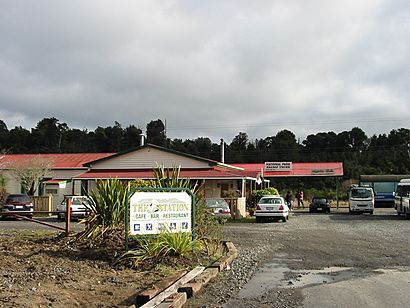National Park railway station, Manawatū-Whanganui facts for kids
Quick facts for kids
National Park
|
|||||||||||||||||||||
|---|---|---|---|---|---|---|---|---|---|---|---|---|---|---|---|---|---|---|---|---|---|
 |
|||||||||||||||||||||
| Location | National Park, Ruapehu District New Zealand |
||||||||||||||||||||
| Coordinates | 39°10′33″S 175°23′35″E / 39.17583°S 175.39306°E | ||||||||||||||||||||
| Elevation | 807 m (2,648 ft) | ||||||||||||||||||||
| Owned by | KiwiRail | ||||||||||||||||||||
| Line(s) | North Island Main Trunk | ||||||||||||||||||||
| Distance | Wellington 346.83 km (215.51 mi) | ||||||||||||||||||||
| History | |||||||||||||||||||||
| Opened | 9 November 1908 | ||||||||||||||||||||
| Previous names | Waimarino until 2 May 1926 | ||||||||||||||||||||
| Services | |||||||||||||||||||||
|
|||||||||||||||||||||
National Park railway station is an important stop on the North Island Main Trunk railway line. It serves the town of National Park in New Zealand's Ruapehu District. This station is a key point for the Northern Explorer train, which travels between Wellington and Auckland. You can even find a cafe right on the platform!
This station is quite high up, at about 807 meters (2,648 feet) above sea level. This makes it the highest railway station in New Zealand that still has regular passenger trains stopping there. Just 5 kilometers (3 miles) north of the station, you'll find the amazing Raurimu Spiral. This is a clever railway track design that helps trains climb or descend a steep hill. It's one of New Zealand's most impressive engineering achievements!
In 2007, there was a small incident at the station. Two Overlander trains had a minor collision when one backed into the other.
Station History
The station and the town were first known as Waimarino, which means "calm waters." But on May 2, 1926, the New Zealand Railways changed the station's name to National Park. This new name was already commonly used because the station is very close to Tongariro National Park. It also helped avoid confusion with other places named Waimarino.
Plans for the station were approved in 1901. A standard "4th class station" building was finished by March 1908. It had rooms for the stationmaster, luggage, and restrooms. The platform was originally 73 meters (240 feet) long. It was made longer several times, reaching 131 meters (429 feet) by 1949.
From 1910 to 1940, there was a Post Office at the station, which even had a telephone from 1914. The station also had a goods shed for storing items, a loading area, and yards for farm animals. Houses were built nearby for the railway staff and stationmaster. A special track called a "crossing loop" allowed trains to pass each other. A snowplough was also kept at the station, ready for winter.
In the 1960s, National Park station became very busy. It was used to transport heavy equipment for the Tongariro Power Scheme Development. This was a big project to create electricity. The roads around the station were improved to handle the heavy trucks. The station itself was also upgraded in 1965. It received a large crane, a weighbridge for heavy loads, and silos for cement. A new, bigger goods shed was built on land that had to be drained first.
An "engine reversing triangle" was built in 1912. This was a special track layout that allowed train engines to turn around. It was still there in 1963, but by 1973, it had become overgrown.
Logging and Timber
When the Main Trunk Line opened in 1908, it created a huge chance for logging companies. They could cut down large trees in the native forests and send the timber away. About 30 sawmills and their own small bush tramways were set up just in the National Park area.
In the 1930s, new caterpillar tractors made it even easier to move logs. Because of this, National Park station became one of the busiest places in New Zealand for sending out timber. Today, only one sawmill is still working in the area.
Marton Sash and Door Tramway
The Marton Sash and Door Co. had its own tramway. This line ran about 5 kilometers (3 miles) southwest from the station. A special type of train, an A & G Price 1924 Type Cb 0-4-4-0 locomotive, pulled wagons on this tramway from 1932 to 1948. This locomotive is now preserved at Ferrymead. The mill itself opened in 1934. Today, part of this old tramway has been turned into a 16-kilometer (10-mile) cycleway, which opened in 2014.
Images for kids


